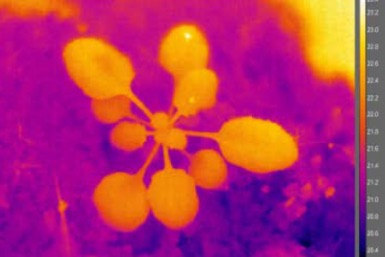Biologists from Utrecht University describe a new molecular mechanism that allows plants to optimize their growth under suboptimal high temperature conditions. The study offers promising leads for the development of climate warming-tolerant crops, which maintain a high yield under stressful high ambient temperatures, according to research leader Martijn van Zanten. They publish their findings in PNAS.
Many crops suffer from high temperatures and each degree Celsius temperature increase can lead to up to 10 percent crop loss. This is a major problem in the context of current global warming and increasing demands for food. However, many plant species can adjust the shape of their stems and leaves, making them more resilient to high temperatures.
This process is called thermomorphogenesis and leads to an ‘open body plan’, allowing efficient evaporation, reduction of direct heat radiation from the sun and enables dissipation of the heat by improved air circulation around leaves. Thermomorphogenesis thus facilitates cooling and enables the plant to maintain optimal growth and production under sub-optimal high ambient temperatures. But many modern agricultural crops have lost that capacity.
Thermotolerant crops
The development of thermotolerant crops requires detailed knowledge of how plants perceive high temperatures and how they translate this signal into growth adjustments. “How plants detect temperature and which molecular factors contribute to thermomorphogenesis is, however, still poorly understood”, explains last author Martijn van Zanten of Utrecht University, who led the international team of researchers from Utrecht, the United Kingdom, Italy, Sweden, Czech Republic, Australia and Wageningen. “We discovered an unknown molecular mechanism by which plants control thermomorphogenesis, especially in young seedlings, the most sensitive period in the plant’s life when it comes to ambient temperature. These new pieces of the puzzle can make the development of future thermotolerant crops more efficient.”
In the journal PNAS, the researchers demonstrate that the enzyme Histone Deacetylase 9 (HDA9) plays a key role in thermomorphogenesis in the widely used model plant Arabidopsis thaliana. At increasing temperatures, the abundance of the enzyme rises, which results in the removal of epigenetic modifications of DNA-bound Histone proteins that have an inhibiting effect on the synthesis of the well-known plant growth hormone auxin. As a result, auxin levels increase and the plant adjusts its stature.
Plant growth
“This new mechanism is scientifically very interesting, because it shows that a Histone Deacetylase 9 has an indirect positive effect on transcription, while Histone Deacetylases are generally accepted as suppressors of this process”, says Van Zanten. “In addition, we show that HDA9 works independently of the only known temperature sensor, phytochrome B, which is also a light sensor. In doing so, we are exposing a new temperature signalling route in plants.”
According to the researchers, this finding offers interesting possibilities for application.
“We show that mutants in HDA9 are disturbed in the ability to adjust their body plan to high temperatures, but can still react normally to light signals from neighboring plants in dense vegetation. With this knowledge at hand, we now can uncouple light-controlled plant growth from temperature-controlled adjustments”
says Van Zanten.
This research therefore offers interesting starting points for the development of climate-warming-tolerant crops, without compromising on other desirable properties.
Read the paper: PNAS
Article source: Utrecht University
Image credit: Utrecht University








